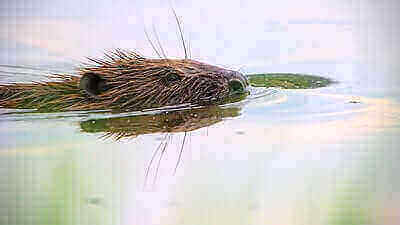Disclosure: We may earn commissions if you purchase products after clicking on a link from our site.
Are you eager to learn how to hunt beavers? Hunting these elusive creatures requires patience, skill, and strategic planning. In this article, we’ll guide you through the step-by-step process, ensuring you’re fully equipped to embark on a successful beaver hunting adventure.
In this article, we will begin by discussing beaver hunting and exploring the challenges and rewards that come with it. Then, we’ll discuss the essential gear and techniques needed to pursue these elusive creatures effectively. In the end, it is our goal to help you be more successful when hunting beavers.
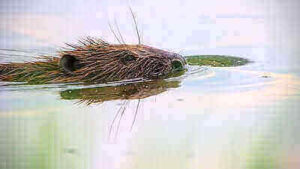
Table of Contents
How To Hunt Beavers
1. Scouting
Scouting beavers involves surveying their habitats and activities to identify potential locations for hunting or wildlife management purposes. Beavers are primarily found in wetland areas, including rivers, streams, ponds, and marshes, where they construct dams and lodges to create suitable habitats.
When scouting, individuals look for signs of beavers, such as gnawed trees, felled logs, dam structures, lots of twigs, and lodge entrances. With sharp teeth, beavers work on tree parts and tree trunks. Additionally, tracks, trails, and chew marks on vegetation can provide valuable clues about recent beaver activity in the area.
Trail cameras or game cameras can also be utilized to monitor beaver movements and behaviors, providing insight into their routines and preferred locations. By thoroughly scouting beaver habitats and gathering information, individuals can develop effective strategies for managing beaver populations or planning hunting expeditions by local regulations and conservation practices.
2. Territorial Rights
Beavers are territorial by nature, exhibiting strong territorial behaviors within their colonies and surrounding habitats. Each beaver colony typically occupies a defined territory centered around a main lodge or beaver dam structure.
Within this territory, beavers construct and maintain their lodges, dams, and associated waterways, which serve as their primary shelter and food storage areas. Beavers defend their territories against intruders, including other beaver colonies, by marking boundaries with scent markings and engaging in aggressive behaviors such as vocalizations, tail slapping, and physical confrontations.
Additionally, dominant beavers within a colony may assert their dominance over subordinate individuals, establishing hierarchical structures within the group. This territorial behavior helps regulate population densities, control resource availability, and maintain social cohesion within beaver colonies, contributing to their overall survival and reproductive success in their natural habitats.
3. Wind Direction
The wind direction is crucial when hunting beavers, as it can affect the hunter’s ability to approach undetected and minimize the risk of alerting these sensitive animals. Always keep track of the wind direction. Beavers rely heavily on their keen sense of smell to detect potential threats, and they can quickly become wary if they catch a whiff of human scent.
Therefore, hunters should strive to position themselves upwind of the targeted beaver habitat, ensuring that their scent is carried away from the area where the beavers are likely to be active. By taking advantage of favorable wind conditions, hunters can approach stealthily and increase their chances of observing or ambushing beavers without alerting them to their presence.
Additionally, hunters should periodically monitor wind direction throughout the hunt and adjust their positioning accordingly to maintain a strategic advantage and maximize their opportunities for success. Similarly, the hearing of a beaver is good even though a beaver’s vision is not so good.
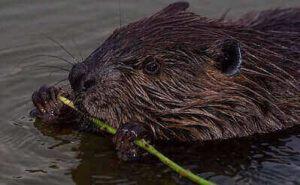
4. Scent Control
Scent control is paramount when hunting beavers, as these animals rely heavily on their acute sense of smell to detect potential predators or intruders. To minimize the risk of alerting beavers to their presence, hunters should take proactive measures to manage their scent effectively.
This includes using scent-free soaps and detergents when washing hunting gear and clothing, storing equipment in airtight containers or scent-proof bags to prevent contamination, and avoiding exposure to strong odors such as tobacco smoke or perfumes.
Additionally, hunters can utilize scent-masking products such as cover scents or odor-neutralizing sprays to help conceal their human scent and blend into the natural surroundings more effectively. By adopting meticulous scent control practices, hunters can increase their chances of approaching beavers undetected and achieving a successful hunt.
5. High-Quality Optics
Using high-quality optics is essential when hunting beavers, as it allows hunters to observe these elusive animals from a distance with greater clarity and precision. Beavers are typically active around dawn and dusk or during the night, making it challenging to spot them in low-light conditions.
By investing in premium binoculars or spotting scopes with superior light-gathering capabilities and image clarity, hunters can enhance their ability to locate beavers and assess their behavior from a safe distance.
Additionally, high-quality optics equipped with advanced features such as image stabilization, low-light performance, and waterproofing ensure reliability and durability in various hunting environments, including wetlands, rivers, and marshes where beavers are commonly found.
With the aid of top-notch optics, hunters can effectively scout for beaver activity, identify potential hunting opportunities, and make accurate shots when the time comes, leading to a more rewarding and successful hunting experience.
Quality binoculars and rifle scopes will help you hunt beavers in dark environments. We reviewed the best hunting binoculars and the best hunting riflescopes that you can read from these links.
6. State Laws
Learning your state’s laws regarding hunting beavers is essential for any prospective hunter seeking to pursue these animals legally and responsibly. Regulations regarding beaver hunting can vary significantly from state to state, governing aspects such as beaver season, trapping season, bag limits, permissible hunting methods, licensing requirements, and designated hunting areas.
Before embarking on a beaver hunting excursion, hunters should thoroughly research and familiarize themselves with the specific regulations outlined by their state wildlife agency or Department of Natural Resources. This information can typically be found on the agency’s website or in official hunting guides and handbooks.
Additionally, hunters should stay informed about any updates or changes to hunting regulations, as they may vary from year to year. By adhering to state hunting laws and regulations, hunters can ensure compliance with legal requirements, contribute to wildlife conservation efforts, and promote sustainable management of beaver populations for future generations to enjoy. You can find your state’s hunting laws on this website.
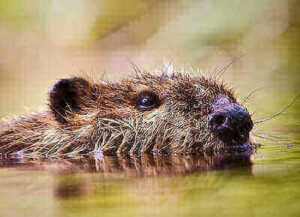
7. Beaver Tough
Beavers are renowned for their toughness and resilience, making them a formidable quarry for hunters. If shot and wounded, beavers have a remarkable ability to quickly dive below the water surface, utilizing their strong tails to propel themselves to safety.
Once under the water levels, locating a wounded beaver becomes a major challenge, as they can remain hidden beneath the water’s surface for extended periods. This evasive behavior poses a significant obstacle for hunters, as the slim chance of finding a wounded beaver underscores the need for accurate and precise shooting to ensure a successful harvest. Some hunters prefer taking a head shot to deliver a fatal blow.
8. Set Up Location
From your scouting trips, look for feeding areas on land. When you find them, set them up. Your best shot will be taken when it isn’t in the water. Don’t shoot beavers when they are swimming in water as your chance of a direct hit is slim.
Additionally, a wounded beaver will go underwater and swim for the entrance of its lodge. It may die in the water while trying to reach it. This is a major beaver problem that some beaver hunters often encounter.
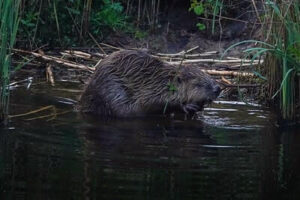
Beaver Lodges
Beaver lodges are remarkable structures constructed by beavers to serve as their primary shelter and refuge. Typically located in bodies of water such as ponds, lakes, and streams, these lodges are built using a combination of materials such as sticks, logs, mud, and vegetation.
The lodge’s architecture consists of a dome-shaped mound with an underwater entrance, protecting it from predators and harsh weather conditions. Inside the lodge, beavers create a series of chambers, including a main living area and additional storage spaces for food and nesting.
The lodge’s design helps regulate temperature and humidity levels, providing a comfortable and secure habitat for the beaver family. Beaver lodges also play a crucial ecological role by creating habitat diversity and supporting a variety of plant and animal species. These remarkable structures are a testament to the ingenuity and adaptability of these industrious rodents.
Hunting Beavers
Hunting beavers may decrease the beaver population and affect the ecosystem in North America. Wolves, bears, and other animals feed on beavers. This may lead to an increase in attacks when they are hungry and can’t find beavers.
Moreover, beaver ponds increase carbon storage by trapping sediments and maintaining open water areas that drain into meadows. This creates habitats for fish, frogs, turtles, and other marine life. Muskrats, minks, and otters benefit from beaver ponds.
Beaver Hunting Equipment
1. Water Resistant Boots
Water-resistant boots are essential and proper gear for beaver hunting, as they provide protection and comfort in the wet and muddy environments typically inhabited by these animals. When pursuing beavers in their aquatic habitats, hunters often encounter soggy terrain, marshy areas, and shallow water bodies.
Water-resistant boots help keep the hunter’s feet dry and comfortable, preventing moisture from seeping into the footwear and causing discomfort or blisters during extended periods of hunting. Additionally, these boots offer excellent traction and stability on slippery surfaces, such as muddy banks or submerged logs, reducing the risk of slips and falls.
Opting for boots specifically designed for water resistance ensures durability and performance in challenging conditions, allowing hunters to focus on their pursuit without distraction or discomfort. With water-resistant boots as part of their hunting gear, hunters can confidently navigate wet environments and pursue beavers with greater efficiency and comfort. You can read a review of the best hunting boots from this link.
2. Binoculars
Binoculars are indispensable gear for beaver hunting, enabling hunters to observe these elusive animals from a safe distance with enhanced clarity and precision. Beavers are often wary and sensitive to human presence, making it challenging to approach them closely without spooking them.
With binoculars, hunters can scout for beavers from a concealed vantage point, allowing them to study their behavior, movements, and habitat without disturbing them. High-quality binoculars with features such as high magnification, wide field of view, and superior light-gathering capabilities are particularly advantageous for beaver hunting, especially in low-light conditions or dense vegetation.
By investing in reliable binoculars as part of their hunting gear, hunters can improve their ability to locate beavers, assess their surroundings, and plan their approach strategically, leading to more successful and fulfilling hunting experiences.
3. Riflescopes
Riflescopes are essential gear for beaver hunting, providing hunters with enhanced accuracy, precision, and target acquisition capabilities. When hunting beavers, which are often found in remote and secluded areas, a well-equipped rifle with a quality riflescope can significantly improve a hunter’s chances of success.
Riflescopes allow hunters to achieve better aim and shot placement, particularly when targeting beavers from a distance or in low-light conditions. Features such as variable magnification, illuminated reticles, and durable construction make riflescopes ideal for adapting to various hunting scenarios and environments encountered during beaver hunts.
Additionally, riflescopes equipped with ballistic compensation reticles or turret adjustments enable hunters to compensate for bullet drop and windage, ensuring more accurate long-range shots. By incorporating a reliable riflescope into their hunting gear, hunters can enhance their shooting performance and increase their effectiveness in harvesting beavers ethically and efficiently.
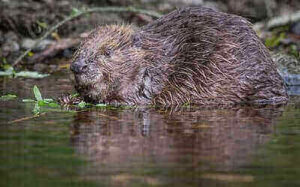
4. Boat/Water Vessel
A boat or water vessel is indispensable gear for beaver hunting, offering hunters access to remote and inaccessible areas where these elusive animals often reside. Whether navigating through winding waterways, traversing marshes, or crossing large bodies of water, a boat provides hunters with mobility, versatility, and the ability to cover vast distances efficiently.
Flat-bottomed boats, canoes, or kayaks are particularly well-suited for beaver hunting, as they can navigate shallow waters and narrow channels where beavers build their dams and lodges. Additionally, using a boat allows hunters to transport gear, scouting equipment, and harvest game with ease, enhancing the overall hunting experience.
By incorporating a boat or water vessel into their hunting gear, hunters can explore diverse habitats, access prime hunting locations, and increase their chances of success in harvesting beavers while enjoying the serenity and beauty of the natural surroundings.
Skinning A Beaver
When skinning a beaver, pay special attention to its special glands called castor sacs. It emits a smelly substance called castoreum which beavers use to mark their territory.
Moreover, don’t damage this gland as the scent from castoreum is difficult to get rid of. Be careful and take precautions when skinning a beaver.
Skinning a beaver involves several steps to ensure the hide is properly removed without damaging it. Here are the steps numbered for clarity:
- Preparation: Lay the beaver on its back with its hind legs spread apart. Ensure you have a sharp knife, a skinning gambrel or hook, and a clean workspace.
- Incision: Make a shallow incision around the beaver’s hind legs, just above the ankles. Cut through the skin around the leg, being careful not to penetrate too deeply to avoid piercing the hide.
- Peeling: Use your fingers to separate the skin from the underlying tissue, gradually working your way up the legs towards the body. Pull the skin downwards as you go to loosen it from the carcass.
- Abdominal Incision: Make a vertical incision along the underside of the beaver, from the groin area to the base of the neck. Take care not to puncture the intestines or other internal organs.
- Skinning the Body: With the abdominal incision made, continue to peel the skin away from the body, using short, careful strokes with your knife to separate any connective tissue.
- Removing Limbs: Once the skin is loosened around the body, cut through the joints of the front legs and carefully peel the skin down towards the head.
- Head and Ears: When you reach the head, cut around the base of the ears and carefully peel the skin down over the skull. Take care around the eyes and nose to avoid damaging the hide.
- Tail: Finally, cut around the base of the tail and pull the skin down over it, removing any remaining tissue as needed.
- Trimming: Once the skin is completely removed, trim away any excess fat or tissue from the hide to ensure it is clean and ready for tanning.
Following these steps ensures that the beaver hide is properly removed and preserved for further processing or tanning.
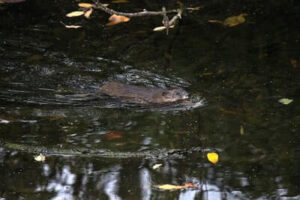
Beaver Hunting Tips
1. Beavers live in family groups called beaver colonies.
2. Beavers can remain submerged in water for up to 15 minutes and will go to the depths at the slightest sign of intruders.
3. The beaver uses its paddle to warn other beavers of danger by striking the surface of the water.
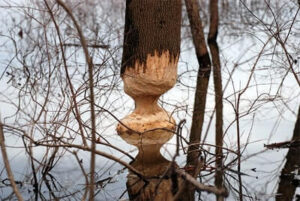
4. Beavers are very territorial. They use a very smelly substance called castoreum from special glands called castor sacs to mark their territories.
5. Beavers are a keystone species within the ecosystem as it has a profound effect on their surrounding natural habitat and the species within it.
6. When scouting an area for signs of beaver activities, look for structures they build called lodges and dams.

7. Beavers have poor eyesight; therefore you really don’t need camouflaged clothing when hunting beavers.
8. Beavers have a good sense of smell. Always hunt downwind of the beavers.
9. Beavers don’t like to travel far on land as they are more vulnerable to predators. Hence beaver travels not far from where they reside.
10. Beavers are mostly nocturnal and attentive animals.
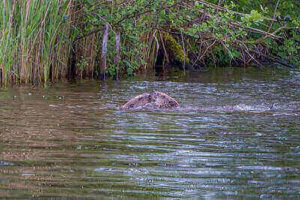
11. Beavers are tough animals. A beaver that is fatally shot can still reach water and submerge. If a wounded beaver reaches and submerges in water, you will not find it.
12. Don’t shoot a beaver when it is swimming in water. Your chances of a good hit are very slim. Additionally, even if you made a direct hit, it will submerge and try to swim for the entrance of its lodge.
13. Beavers can pick up vibrations on the shore. Therefore; be very careful and walk lightly as you walk along the shore looking for beavers.
14. Beavers have a good sense of hearing. They can pick up vibrations from land and, therefore walk lightly.
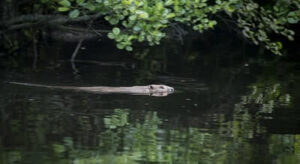
15. Avoid stepping in the water along the banks as they will pick up the vibration and disappear.
16. Sadly, one way to lure beavers out is to partially damage their dams and lodges. When they discover the damage, they will work to quickly repair it. You can set up and wait until they have completed the repair and come out of the water to feed.
17. Beavers are also destructive and can cause a lot of damage to properties. Many states encourage property owners to work with local authorities to remove beavers from near their properties.
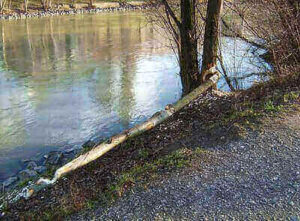
The Bottom Line
Beaver is the largest rodent and some of the toughest animals. They are challenging to hunt with their good sense of smell and hearing. They are innovative, clever, and innovative animals. In this article, we share information and knowledge to help you hunt beavers. There are different forms of hunting beavers used by hunters.
Beaver trapping is also used by hunters to trap beavers. The trap type will depend on the hunter’s preference. Foot-hold traps, and body grip traps, are some of the trap types for hunting adult beavers. A trapping license is often needed therefore, it is a good idea to check the hunting laws.
Beavers can also be a nuisance to private property where they become resident beavers and cause property damage. The removal of beavers then becomes the best way to deal with them and a wildlife control operator works with the property owner to remove the beavers..
If you are interested in hunting groundhogs, read how to hunt groundhogs. You can also read how to hunt javelinas, how to hunt hogs, how to hunt wild sheep, and how to hunt raccoons.
